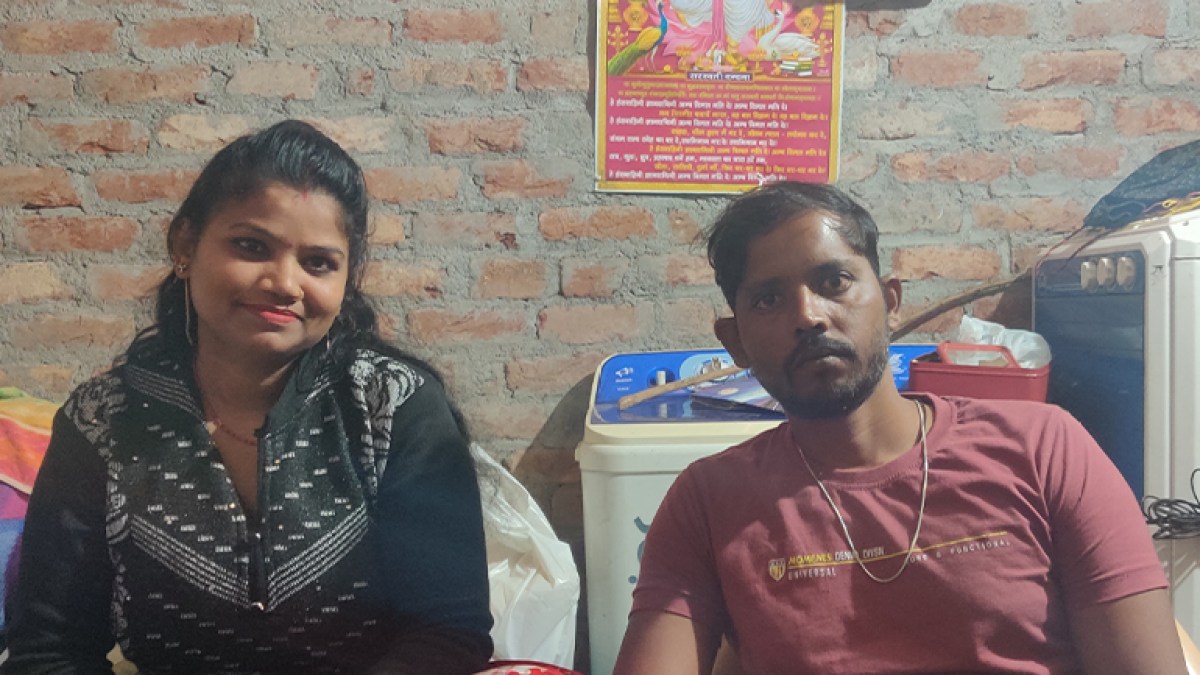Cost of living: An Indian family’s struggle to escape their slum
Listen to this story:
New Delhi, India – A long-tailed lizard dances in and out of the gaps in the asbestos sheet ceiling of Gunja and Chand Singh’s new house in Tughlakabad village, a neighbourhood in the Indian capital.
It is about 3pm, and the couple is sitting in their bedroom sipping tea their younger son, Arjun, has just made.
Gunja and Chand, among India’s four million waste pickers, moved into their bare-brick home in October and are house-proud.
It took them 15 years of back-breaking work and sacrifices to save enough money to buy a plot of land in March 2022. To construct the house and pull themselves and their two school-going teenage sons out of the nearby slum where they lived for 12 years, they took a loan from the man who sold them the plot.
They kept their old shanty — their old home — and the adjoining godown, a storage area with three walls and a plastic and bamboo roof, both a short walking distance from their new house. This godown is where Chand separates paper, cardboard, plastic and other waste material that he and the workers he hires collect from neighbourhoods to sell to recyclers.
Along with his waste collection work, Chand used to sweep at a garment manufacturing unit where he was not paid but was allowed to take home discarded strips of cloth for Gunja to sort and sell to recyclers.
Depending on the waste he is able to collect and sell, Chand makes 200 to 500 Indian rupees ($2.44 to $6.10) per day – sometimes 1,000 rupees ($12.20) – while Gunja used to earn 150 to 400 rupees ($1.83 to $4.88) a day sorting scrap fabric from the factory according to colour and material and selling it.
“Each bag would fetch 150 rupees to 200 rupees ($1.83 to $2.44). Some days I would have two bags,” says Gunja. With these earnings, they were able to buy a month’s supply of dry goods — cooking oil, lentils, rice, flour, masala — and milk and save 4,000 to 5,000 rupees ($48.82 to $61) a month.
“We were even able to save money to buy the house,” Gunja says. “But since the COVID-19 lockdown, income has really fallen.”
While business has gone down, expenses have gone up.
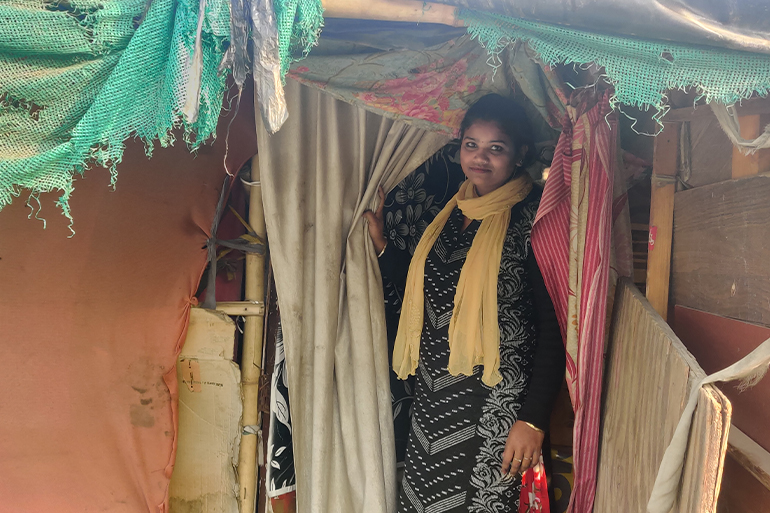
Earning less
India is home to 228.9 million poor people and the world’s highest number of people — 83 million — living in extreme poverty. But it also has the unique distinction of large-scale upward mobility. Between 2006 and 2021, about 415 million Indians exited what the United Nations Development Programme calls “multidimensional poverty”. This measure goes beyond the UN’s $1.90-a-day definition of poverty and focuses on 10 indicators, including nutrition, schooling, and access to cooking fuel, sanitation, housing and drinking water. But globally, the coronavirus pandemic has set back progress in reducing poverty by five to nine years. The people hardest hit have been the poor in developing countries such as India.
A series of strict lockdowns in India that began in March 2020 disrupted manufacturing, supply and distribution, and many small businesses and jobs while raising food prices. More than 21 million people became unemployed in the first year of the pandemic and the income of about 97 percent of households declined. In 2022, the economy was dealt another blow by the ongoing Russia-Ukraine war when the cost of fuel and living went up.
Many families that had managed to move up the economic ladder are now in survival mode, including the Singhs.
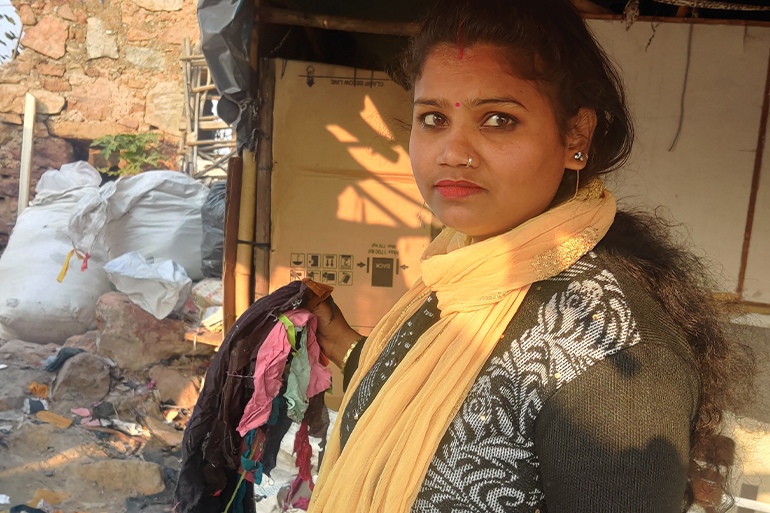
Gunja, who got married at 13, has spent most of her life sorting waste. The 32-year-old smiles a lot and speaks her mind. She wears vermillion in the parting of her hair and a “mangal sutra” (auspicious thread) around her neck like many married Hindu women.
She has never learned to read or write but is ambitious and aspires to become a professional Bhojpuri singer. She often posts Instagram videos of her singing as well as snippets of her daily life. In December 2020, Gunja created her own YouTube channel, and the couple paid a studio to record 10 original songs and shoot a video for one. But she has had to put this dream on hold until Chand’s income picks up again.
“Earlier,” says Gunja, “he used to leave early in the morning, pedalling his tricycle cart to collect waste from 40 to 50 homes.”
But in recent years, with the prices of recycled materials dropping, he has been forced to scale up to try to earn the same amount. To do this, he has to hire two or three daily wage workers to collect and sort waste from 100 to 200 homes a day. He then sorts and sells the collected waste to recyclers. Between lower prices and workers and a loan to pay, “he doesn’t earn as much as he used to”, Gunja says.
Then about nine months ago, the factory shut down and Gunja lost her 10,000-rupee ($122) monthly earnings from selling sorted fabric.
Gunja misses the freedom that cash in hand gave her. “Now I have to ask [Chand] for money for even small-small things,” she says, with a tinge of embarrassment. The money she earned was also a buffer the family has now lost.
“Look at the ceiling,” says Chand, 37, who speaks with the urgency of someone late for work. He points at a long, 2.5cm-wide (1-inch-wide) gash above their bed. “It’s broken but there are too many expenses and I can’t afford to fix it right now. First I have to clear the debt for the house.”
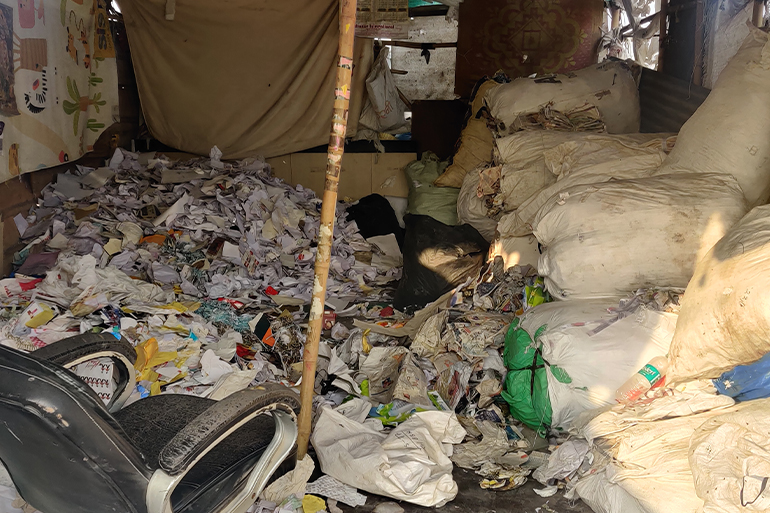
Harassed for repayments
The house Gunja and Chand are living in costs about 800,000 Indian rupees ($9,764), but the couple could put down just 200,000 rupees ($2,441). The rest has to be paid as monthly instalments, but they have fallen behind on the repayments and the man who lent them the money has been calling and harassing Gunja.
“He was asking for 30,000 rupees [$366.16] per month and pestering me for payment. I told him that we can’t pay that much,” Gunja says, her usually smiling face worried.
Chand asked him not to call his wife and negotiated a payment of 10,000 rupees ($122) per month. Even so, three instalments are now due. Business did not go very well in December.
“Today I have earned nothing, not even one rupee. In winter there is very little kooda [garbage],” Chand said in December.
In Delhi’s winter, temperatures dip to 3-4C (37-39F) and not everyone can afford heating. Many forage for paper and cardboard to burn and stay warm at night.
Less waste to gather only compounds the difficulties posed by lower rates, particularly for cardboard and water bottles, which fetch the best prices.
“I used to sell plastic water bottles and cardboard for 10 to sometimes 24 rupees ($0.12 to $0.29) per kilogramme, but now the rate of local cardboard has dropped to 5 to 7 rupees ($0.06 to $0.085) because people are getting good stuff from abroad,” says Chand, referring to recyclers who prefer to buy from importers with India being the world’s largest destination for waste paper.
Anxious, he suddenly gets up. “I’m going to the godown,” Chand says, hoping he can make some money. But waste collection is done early in the morning, and it is already 4pm.
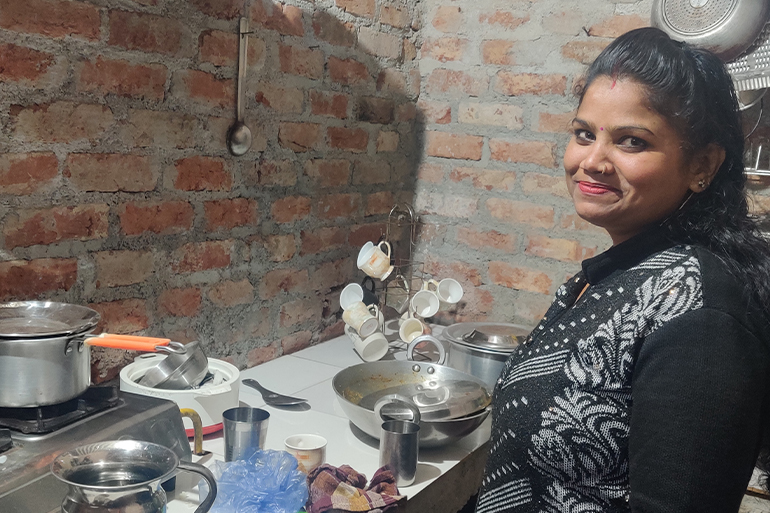
An unaffordable textbook
A steel milk can hangs from a nail in Gunja’s new bedroom. It has been four months since she stopped buying fresh milk from the dairy because its price doubled to 100 rupees ($1.22) a litre as a result of cattle fodder for dairy cows getting more expensive. “I used to give my kids a glass of milk every day and make tea. But now I buy a half-litre packet of pasteurised milk for less than half a dollar, just enough for us to have a cup of tea each in the morning,” says Gunja. That cup of tea is all Chand will have until he returns home for lunch.
The cost of cereals, basic groceries and milk in India has been increasing consistently for a decade. But in the last three years, the rise has been steep.
Though prices are beginning to stabilise, the Singh family cannot afford to eat like they used to. Gunja says she has stopped buying pulses and lentils although that is what her kids really like to eat. The day Al Jazeera visited, she had made rice and potato-brinjal stir fry. It was delicious, distinctly spicy and cooked as though to take everyone’s mind off the missing bowl of lentils which would ordinarily accompany the meal.
“Our expenses were in control when the kids were young. Now that they are older, expenses too have shot up,” says Chand. They have to buy more, but everything also now costs more. He lists out the approximately 4,000 rupees ($48.82) he spends every month on their clothes, pocket money, television cable connection and mobile data.
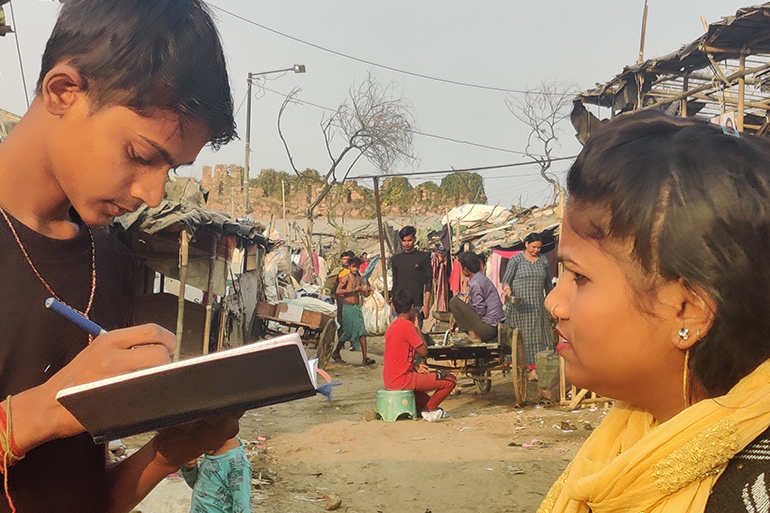
Both their sons, Karan, 14, and Arjun, 12, go to an English-medium government school nearby. There is no school fee but they need books and private after-school tuition. Gunja was paying a monthly 1,200-rupee ($14.65) fee for a private tutor but stopped that a year ago because she could not afford it.
“Karan is very good in studies and I am hoping he will join the army,” says Gunja. But for that, he has to first clear the centralised Class 10 exam in two months. And to study for that, he needs to buy a particular book.
The teacher keeps reminding Karan, who, in turn, keeps reminding Gunja. The English textbook is on top of her mind, but she does not have 1,300 rupees ($15.87) to pay for it.
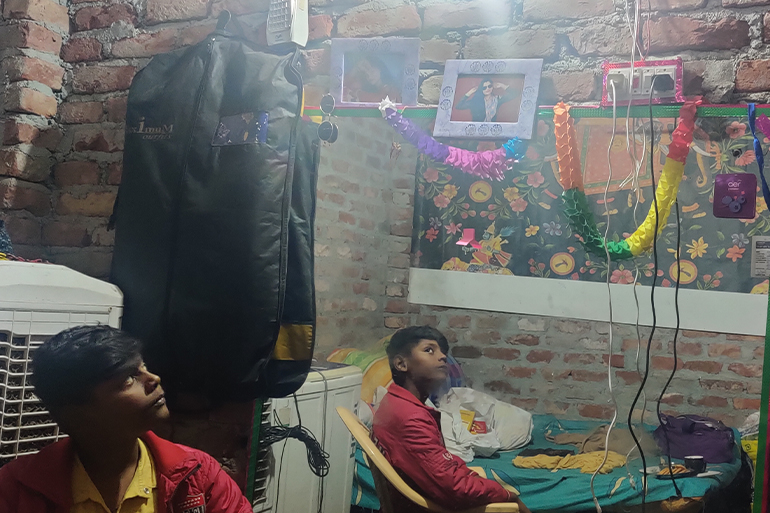
A sink with no tap
Gunja and Chand’s two-bedroom house is a mix of something old, something new and many things missing.
Each bedroom — hers and her children’s — has a large mirror. These are gifts from her brother, a waste picker in one of Delhi’s poshest colonies (neighbourhoods). The mirrors make the rooms feel bigger and draw attention away from the rest of the house, where the bare-brick walls, held together by sand and cement, feel precarious.
“I have a sink but haven’t put a tap yet,” Gunja says, standing in the kitchen. Instead, she uses a bucket to draw water from an underground tank.
There are no taps in the bathroom and toilet either because Gunja and Chand’s house is built illegally on government land around a protected monument, the 14th-century Tughlaqabad Fort.
Delhi, a city of 19 million, is built around forts and villages with large tracts of disputed land which have, over time, become slums and illegal colonies that offer affordable housing to the city’s seven million migrant population.
Gujjars, a powerful landed community, claim to be the original inhabitants of the land around Tughlaqabad Fort and are fighting an ownership battle in court. There is no outcome yet, but the community has been selling small plots, including to Gunja and Chand, without any documentation, and at a quarter of what the price would be if the colony were legalised and had an electricity connection, piped water supply or sewage system.
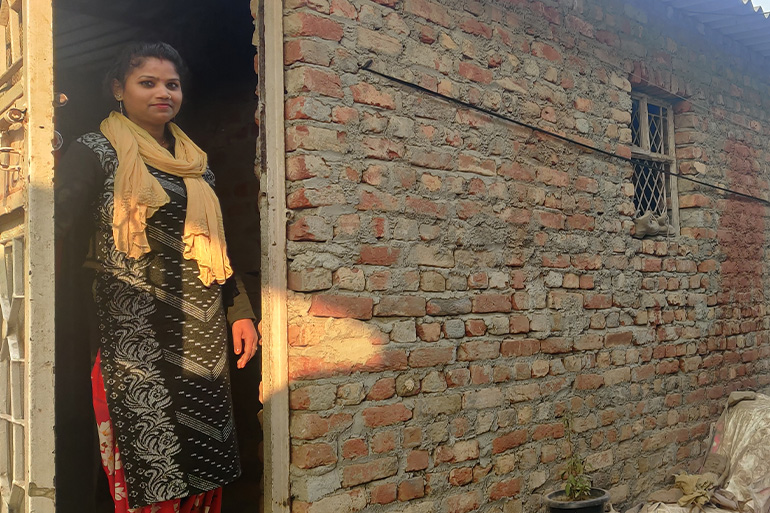
‘First we have to pay the house loan’
The landlords have also used the quintessentially Indian trait of jugaad (makeshift arrangement) to organise everything and make money off it.
A tanker arrives every 15 days and fills Gunja and Chand’s underground water tank for 500 rupees ($6.10). When she can afford to pay 15,000 rupees ($183), Gunja says she will buy an overhead water tank, a motor to pump water up, and taps.
A month’s electricity costs them 200 rupees ($2.44) and comes via a wire hooked on to the main power line nearby. This “power theft” is dangerous and was reportedly the cause of at least one of the three fires that ravaged the slum they were living in.
In May 2020, about 1,700 shanties — including their old home — were reduced to ashes, and they had to rebuild their home with strips of tarp, plastic, bamboo, cardboard and strings.
“If the government wants to demolish our house, this colony, they can,” says Chand matter-of-factly.
Gunja is worried about the house, but also about launching her singing career.
“My one song,” she says, “became a huge hit and it was about to reach a million views when the studio removed it.” A million hits means money and paid gigs at local functions. But the studio, Gunja says, did not want to share profits with her.
Chand, who put the money towards her recordings, says he wants to support her.
“My wife is illiterate. If she does something, learns something and starts earning, then my children’s life will get better,” he says. “But first we have to pay the house loan.”

